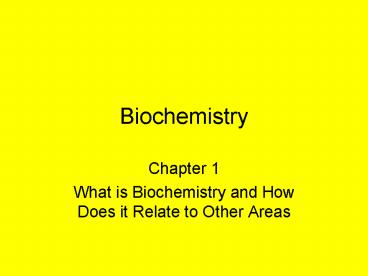Biochemistry - PowerPoint PPT Presentation
1 / 11
Title: Biochemistry
1
Biochemistry
- Chapter 1
- What is Biochemistry and How Does it Relate to
Other Areas
2
Biochemistry
- Defined as the science concerned with the
chemical basis of life - Expanded definition The science concerned with
the chemical constituents of living cells and
with the reactions and processes they undergo
3
- Biochemistry is the common thread that links all
life sciences - The book does a good job of linking Biochemistry
with Biology, Molecular Biology, Cell biology,
physics, and chemistry - The relationship between Biochemistry and
Medicine has also stimulated mutual advances
4
- The World Health Organization (WHO) defines
health as a state of Complete physical, mental,
and social well-being and not merely the absence
of disease and infirmity - From a biochemical view, health may be considered
that situation in which all of the many thousands
of intra- and extra-cellular reactions that occur
in the body are proceeding at rates commensurate
with the organisms maximal survival in the
physiological state
5
- We believe that most, if not all, diseases are
manifestations of abnormalities of molecules,
chemical reactions, or biochemical processes. - As a matter of fact, the major factors for
causing diseases in animals and humans fall into
one or more of eight categories.
6
- Physical agents
- Mechanical trauma, extremes of temperature,
sudden changes in atmospheric pressure,
radiation, electric shock - Chemical agents
- Drugs, toxins, therapeutic drugs, etc
- Biological agents
- Viruses, bacteria, fungi, higher forms of
parasites - Oxygen lack
- Loss of blood supply, depletion of the
oxygen-carrying capacity of the blood, poisoning
of the oxidative enzymes
7
- Genetic Disorders
- Congenital, molecular
- Immunologic reactions
- Anaphylaxis, autoimmune disease
- Nutritional Imbalances
- Deficiencies, excesses
- Endocrine imbalances
- Hormonal deficiencies, excesses
8
Uses of Biochemical investigations and laboratory
tests in relation to diseases
- To reveal the fundamental causes and mechanisms
of diseases - Demonstration of the nature of the genetic
defects in cystic fibrosis - To suggest rational treatments of diseases based
on (1) above. - A diet low in phenylalanine for treatment of
phenylketonuria - To assist in the diagnosis of specific diseases
- Use of the plasma enzyme creatine kinase MB
(CK-MB) in the diagnosis of myocardial infarctions
9
- 4) To act as screening tests for the early
diagnosis of certain diseases - Use of measurement of blood thyroxine or
thyroid-stimulating hormone (TSH) in the neonatal
diagnosis of congenital hypothyroidism - 5) To assist in monitoring the progress of
certain diseases - Use of the plasma enzyme alanine aminotransferase
(ALT) in monitoring the progress of infectious
hepatitis - 6) To assist in assessing the response of
diseases to therapy - Use of measurement of blood carcinoembryonic
antigen (CEA) in certain patients who have been
treated for cancer of the colon
10
Three Principal Areas of Biochemistry
- Structural Chemistry
- Metabolism
- Molecular Genetics
11
The Chemical Elements of Living Matter
- Carbon, Hydrogen, Oxygen, Nitrogen, Phosphorus































